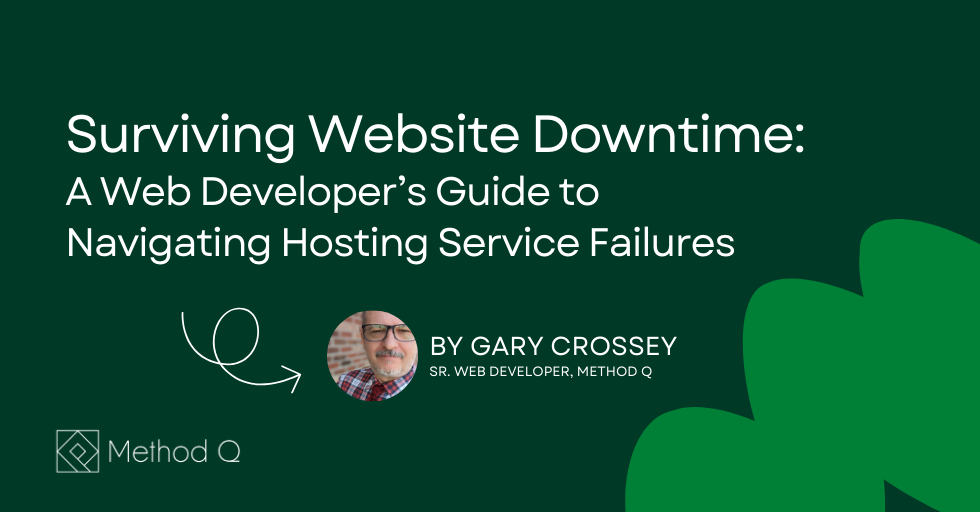Surviving Website Downtime: A Web Developer’s Guide to Navigating Hosting Service Failures
‘
In our fast-paced digital landscape, reliable website uptime is like the heartbeat of the business it serves. As web professionals, we relentlessly ensure our clients’ websites run optimally, delivering crucial services that their customers rely on. But what happens when unforeseen circumstances, like a hosting provider failure, and the website experiences downtime?
Understanding the Impact on Downtime for Business Operations
Website downtime is not a mere technical glitch; it has far-reaching consequences for a business’s revenue, client trust, and reputation. Imagine a prospective customer trying to access your website to make a purchase, only to be greeted by a “server down” message. That customer might not only abandon the purchase but also develop a negative perception of your brand, impacting your credibility and reputation. From a web developer’s perspective, downtime means my clients’ businesses are essentially paralyzed. Their customers can’t access their services, resulting in lost revenue and potentially strained client relationships. It’s a situation that no business owner or web developer wants to face, emphasizing the importance of proactive measures to prevent downtime and ensure a seamless online experience for clients.
During a particularly trying week, I experienced two separate incidents that significantly disrupted website operations. The initial incident spanned two days, while the second, occurring just five days later, was estimated to last for another three days. This resulted in a total of five days of downtime within a single week, a situation that posed a significant challenge for any online business.
Setting Realistic Hosting Support Expectations
In the throes of downtime, clear and unwavering communication from your hosting provider is the lifeline you crave. But, in my experience, mixed messages about updates and callbacks only add fuel to the fire of frustration. Downtime, coupled with inadequate communication, can be a wrecking ball for business operations and a corrosive force on the trust between provider and client.
When downtime strikes, the first thing on your mind is how long you’ll be stranded in the digital wilderness. The tolerable timeframe for downtime varies widely across businesses. In my case, a quoted resolution time of 24 to 72 hours was a bitter pill to swallow. In today’s lightning-fast digital landscape, even a few hours of downtime can send shockwaves through your business.
Maintain Clear and Precise Communication
Be clear and concise in your communication. When reporting an issue to your hosting provider, be as specific as possible about the problem you are experiencing. This will help the provider quickly identify and address the issue.
During downtime, clear and consistent communication from your hosting provider is crucial. In my experience, my former hosting provider offered mixed messaging about when to expect an update and when to call back if the issue wasn’t resolved added to the frustration. Hosting companies must ensure their customers receive timely and accurate information about service issues and what’s being done to resolve them.
Keep a Detailed Record of the Downtime Event
Maintaining a comprehensive record of all communication and exchanges with your hosting provider is crucial when dealing with service issues. This practice involves documenting every detail, including the nature of the problem, the hosting provider’s responses, the timeframe given for resolution, and any other relevant information. This documentation serves several important purposes. Firstly, it can help address any queries or doubts that the client may have about your efforts to resolve the issue. Secondly, it can aid in escalating the issue to higher levels of support or to management if necessary.
In more severe cases, where legal action might be necessary due to the consequences of the hosting provider’s failures, this record can play a pivotal role. It provides concrete evidence of the discussions that took place during the incident, documenting the nature of the problem, the hosting provider’s responses, and the resolution timeframe. This evidence can be presented to legal authorities or mediators to support your case and demonstrate that you have taken appropriate steps to resolve the issue.
Recording conversations and transcripts between the hosting provider and the developer can also provide valuable evidence of the communication during the incident. However, it’s essential to obtain permission before recording any conversations. If recording is part of the support process and all parties are aware of it, additional permission is usually not required. However, it’s always a good practice to explicitly inform all parties involved that the conversation is being recorded.
When seeking permission to record a conversation, it’s important to be transparent about the reasons for the recording. As a web developer dealing with a hosting issue, you could state: “In order to ensure that I fully understand and can accurately implement any instructions or advice you provide, I would like to record our conversation. This recording will also serve as a reference for any potential troubleshooting or follow-up discussions. Are you comfortable with me proceeding with recording our conversation?”
Discover Alternative Web Hosting Options
My heart sank when I saw the “downtime” message on my website. It wasn’t just any downtime; it was an extended one. And it wasn’t the first time, either. My previous hosting provider, who I had a 20-year-long relationship with, just wasn’t cutting it anymore.
As a web developer, I understand the importance of reliable website hosting. My clients depend on me to keep their websites up and running. That’s why, after much deliberation, I decided to switch their site to WP Engine.
WP Engine is a managed WordPress hosting company that offers a range of features and benefits that my previous host provider simply couldn’t match. They have a reputation for providing excellent customer support, and they offer a suite of tools and services that can help me optimize my client’s website’s performance.
I’m glad I made the switch to WP Engine. Since moving my clients’ site, I’ve experienced significantly less downtime, and my clients’ websites performance has improved dramatically. I’m confident that my clients’ websites are in good hands with WP Engine, and I’m excited to see what the future holds for our partnership.
How Can WP Engine Help Avoid Downtime?
WP Engine excels in providing a reliable and secure hosting experience, ensuring your website’s uptime and speed. Their robust infrastructure includes automated backups, real-time threat detection, and a global CDN. Furthermore, their award-winning support team is available 24/7, offering peace of mind that help is always at hand.
It’s important to note that no hosting provider can guarantee 100% uptime, but WP Engine has mechanisms in place to quickly detect and resolve issues, minimizing potential downtime. By choosing WP Engine, you can trust that your website is in safe hands, with a team dedicated to ensuring its optimal performance and security.
As a web developer, it’s imperative to take a proactive approach to handling challenging situations and safeguarding your clients’ websites. Your efforts in staying informed, adapting to new technologies, and maintaining a positive and resilient mindset will set you on a path of continuous growth and success.
To ensure your role as a trusted web developer, it’s crucial to follow these four steps:
- Keep clients informed: Always inform your clients about the situation, explaining that it’s a hosting issue and assuring them that you are doing everything possible to resolve it.
- Have a backup hosting provider: This can allow you to shift your clients’ websites temporarily to another host if your primary host experiences issues.
- Monitor your websites: Implement a system to get notified immediately when your websites go down.
- Regularly backup all your websites: This practice enables you to restore a website quickly on a different server if necessary.
In web development, the ability to navigate hosting provider failures is a rite of passage. I faced this challenge head-on with my former hosting provider. They became the unwitting stars of a learning adventure that underscored the importance of crystal-clear communication, understanding the nitty-gritty of service level agreements, documenting every interaction like a detective, and exploring alternatives with the zeal of an explorer.
The decision to switch to WP Engine wasn’t easy. After all, I had shared a long and storied history with my former hosting provider. But, the need to ensure unwavering reliability for my awesome clients demanded it. And so, with a bittersweet mix of nostalgia and anticipation, I embarked on a new hosting chapter with WP Engine.
To learn more about WP Engine and its services, click the button below. Your website deserves a reliable hosting service.
Click to Learn More about WP Engine Hosting




